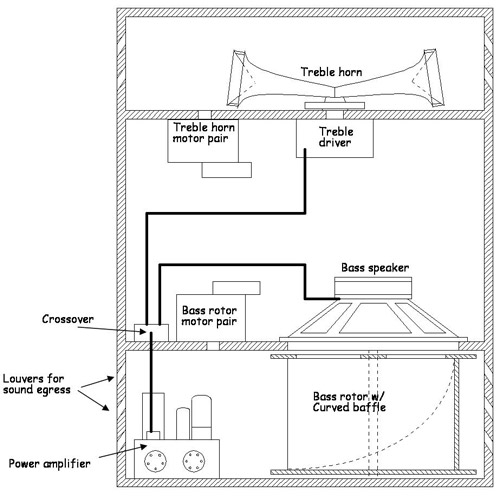LESLIE SPEAKERS
North Suburban HAMMOND ORGAN Service
Figure 3. Diagram looking down into the lower bass rotor which shows the design of the top with openings for sound to enter the scooplike rotary baffle. Notice that it rotates in the opposite direction to the treble horn rotation. Mouse over picture to intiate rotation, if viewing on a cell phone, tap the picture. Tap outside the picture to stop rotation.

Figure 3. Simplified diagram of a typical generic Leslie Speaker. To make the drawing less cluttered, I have left out the belts and pulleys on the rotor motor pairs and the actual rotating elements. Also, note the conical sound deflectors in the top horns to spread out the high frequency components of the sound and eliminate excessive directivity and amplitude tremolo.
It's doubtful that even the most powerful computers in the world, all working together, could accurately calculate all of the different frequency and volume changes that occur during one complete revolution of the rotating horn in a single 122 Leslie Speaker in an average rectangular room.
Now how much of a pitch change is possible with a typical Leslie Speaker? In practice of course, the Leslie does not alter the pitch of the audio signal which it receives from the electronic organ to which it is connected. However, once the sound leaves the open end of the rotating horn, the doppler effect comes into play and accounts for most of these complex frequency shifts in the sound wave.
Anyhow, the typical top horn in a Leslie is about 10 inches long. As it rotates, it moves around in a 20 inch diameter circle. If the rotating speed of the horn is 360 RPM, then the circumferential speed of the open end of the horn is 31.42 feet per second. This is roughly 21 miles per hour. This results in a frequency shift of roughly 2.9 percent or nearly half a semitone. In other words, the maximum apparent pitch deviation that could occur from a Leslie speaker because of the doppler effect is about a quarter of a tone; that is, about half the distance in pitch from, say, C to C#.
Because the Leslie speaker produces a virtually infinite array of vibratos, all deviating in pitch at different times, a listener is not really so much aware of any particular pitch change, but of a very interesting and extremely complex variation that occurs at the typical vibrato rate of roughly 360 to 400 times a minute.
So far we have looked at the upper rotary horn in a typical Leslie speaker. In the central section of the cabinet there is also a 15-inch woofer mounted on the bottom shelf and facing downward into the lowest of the three compartments. Here is a simplified diagram of a typical Leslie such as we are describing which shows the layout of the cabinet and also the significant parts of the device.
Notice the three compartment design and also the sound egress louvers in the sides of the top and bottom sections. Similar louvers also appear on the lower back cover, and the top cover is sufficiently narrow so that when in place it leaves slots about 5/8" wide both above the upper shelf and below the top of the cabinet. This allows sound dispersal from all four sides of the Leslie cabinet. The central compartment is designed as a vented bass-reflex enclosure for the 15 inch woofer and the entire cabinet is fairly compact. Likewise, the somewhat "neutral" design of the cabinet woodwork was the result of careful design studies to result in a speaker cabinet that would look good regardless of the style of the console or the decor of the room where it was installed.
The bass rotor is an angled "scooplike" baffle device, open on one side. All around this rotor is a light cloth curtain or "scrim" which is supposed to reduce windage resistance as this rotor turns. The bass rotor's effect on the lower tones is somewhat different from the effect of the treble horn. First of all, as you get lower in pitch, the wave length of the soundwaves increases dramatically. Bass tones tend to be non-directional, and although there is still some significant Doppler-related phase and pitch changing on the upper end tones of the bass range (those just below 800 Hz.) By the time you are in the lower range of an electronic organ, 100 down to 32.35 Hz, the effect of the lower rotor decreases significantly and results in just a slight amount of amplitude tremolo which, by the time you are in the bottom range of the organ pedal tones disappears completely.
This, however is not at all a bad thing or a defect. Vibrato and tremolo sound really nice in the typical range of general musical tones and higher pitches, but this is not so with low frequency tones which are better off with neither tremolo or vibrato. It is interesting to note that in real pipe organs, it is rare to find the pipe organ tremulant effect applied to any pitches lower than Tenor C which has a frequency of 130.8 Hz. And we must remember that the pipe organ's history goes back over 2000 years and much of what constitutes good pipe organ sound results from centuries of practical experience.
Previous Page Page 4. Next page